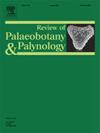Morphological identification of selected spices by starches, calciphytoliths, and phytoliths
IF 1.7
3区 地球科学
Q2 PALEONTOLOGY
引用次数: 0
Abstract
Spices have played a crucial role in shaping human culture and facilitating trade across civilizations. Despite their significance, identifying spices in archaeological contexts remains challenging due to the poor preservation of plant remains. This limitation has hindered our understanding of their historical use and distribution. Here, we used a polarizing microscope to analyze the presence and morphological characteristics of starches, calciphytoliths (calcium oxalate crystals), and phytoliths in 23 different spices. Our analysis revealed that all samples contained at least one type of microfossil, with 11 spices identifiable by starches, 10 by calciphytoliths, and 2 by phytoliths. Notably, Nutmeg (Myristica fragrans), Amomum Fruit (Amomum tsaoko), Kencur (Kaempferia galanga), and Ginger (Zingiber officinale) were identified with higher confidence due to the presence of two or more diagnostic microfossils. This study establishes identification criteria for 18 spices and provides a valuable tool for reconstructing the history of spice use and trade, particularly in regions with poor plant preservation, contributing to a deeper understanding of prehistoric cultural and trade networks.
用淀粉、钙化植岩和植岩对香料进行形态学鉴定
香料在塑造人类文化和促进跨文明贸易方面发挥了至关重要的作用。尽管具有重要意义,但由于植物遗骸保存不善,在考古背景下识别香料仍然具有挑战性。这种限制阻碍了我们对它们的历史使用和分布的理解。在这里,我们使用偏光显微镜分析了23种不同香料中淀粉、钙化植石(草酸钙晶体)和植石的存在和形态特征。我们的分析显示,所有样品都含有至少一种微化石,其中11种香料可通过淀粉识别,10种可通过钙化植物岩识别,2种可通过植物岩识别。值得注意的是,肉豆蔻(Myristica fragrans)、砂果(Amomum tsaoko)、姜(Kaempferia galanga)和姜(Zingiber officinale)由于存在两个或更多的诊断微化石而被鉴定出更高的可信度。本研究建立了18种香料的鉴定标准,为重建香料的使用和贸易历史提供了有价值的工具,特别是在植物保护较差的地区,有助于更深入地了解史前文化和贸易网络。
本文章由计算机程序翻译,如有差异,请以英文原文为准。
求助全文
约1分钟内获得全文
求助全文
来源期刊
CiteScore
3.50
自引率
21.10%
发文量
149
审稿时长
6 months
期刊介绍:
The Review of Palaeobotany and Palynology is an international journal for articles in all fields of palaeobotany and palynology dealing with all groups, ranging from marine palynomorphs to higher land plants. Original contributions and comprehensive review papers should appeal to an international audience. Typical topics include but are not restricted to systematics, evolution, palaeobiology, palaeoecology, biostratigraphy, biochronology, palaeoclimatology, paleogeography, taphonomy, palaeoenvironmental reconstructions, vegetation history, and practical applications of palaeobotany and palynology, e.g. in coal and petroleum geology and archaeology. The journal especially encourages the publication of articles in which palaeobotany and palynology are applied for solving fundamental geological and biological problems as well as innovative and interdisciplinary approaches.

 求助内容:
求助内容: 应助结果提醒方式:
应助结果提醒方式:


